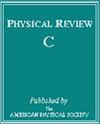各向异性对重夸克束缚态形成的影响
IF 3.4
2区 物理与天体物理
Q1 Physics and Astronomy
引用次数: 0
摘要
我们研究了各向异性等离子体介质中重夸克-反夸克系统静态势的实部。我们采用一种准粒子方法,利用硬环微扰理论来描述等离子体成分的集体动力学。粒子分布函数由一组参数表征,这些参数能够准确描述重离子碰撞中产生的等离子体的各向异性。我们对强各向异性系统中的势进行了数值计算,并研究了相对于各向同性势的畸变的角度依赖性。在弱各向异性的极限中,我们得到了重夸克势实部的解析表达式,该模型用有效屏蔽质量来表示势,而有效屏蔽质量取决于各向异性参数和夸克-反夸克对的取向。我们用角度平均筛选质量来表述一维势,将介质的各向异性纳入径向坐标。我们求解了相应的薛定谔方程,并证明结合能的大小通常会随各向异性而增加。各向异性可以发挥重要作用,尤其是在角动量不为零的状态中。这意味着形成的结合态数量可能取决于等离子体各向异性的具体特征。我们的研究表明,等离子体的各向异性在重夸克鎓的动力学中起着重要作用,并激发了进一步研究的兴趣。本文章由计算机程序翻译,如有差异,请以英文原文为准。

Effect of anisotropy on the formation of heavy quarkonium bound states
We study the real part of the static potential of a heavy quark-antiquark system in an anisotropic plasma medium. We use a quasiparticle approach where the collective dynamics of the plasma constituents is described using hard-loop perturbation theory. The parton distribution function is characterized by a set of parameters that can accurately describe the anisotropy of the plasma produced in a heavy ion collision. We calculate the potential numerically in strongly anisotropic systems and study the angular dependence of the distortion of the potential relative to the isotropic one. We obtain an analytic expression for the real part of the heavy quark potential in the limit of weak anisotropy using a model that expresses the potential in terms of effective screening masses that depend on the anisotropy parameters and the orientation of the quark-antiquark pair. A one-dimensional potential is formulated in terms of angle averaged screening masses that incorporate the anisotropy of the medium into a radial coordinate. We solve the corresponding Schrödinger equation and show that the magnitude of the binding energy typically increases with anisotropy. Anisotropy can play an important role, especially in states with nonzero angular momentum. This means that the number of bound states that are formed could depend on specific characteristics of the anisotropy of the plasma. Our study suggests that plasma anisotropy plays an important role in the dynamics of heavy quarkonium and motivates further study.
求助全文
通过发布文献求助,成功后即可免费获取论文全文。
去求助
来源期刊

Physical Review C
物理-物理:核物理
CiteScore
5.70
自引率
35.50%
发文量
0
审稿时长
1-2 weeks
期刊介绍:
Physical Review C (PRC) is a leading journal in theoretical and experimental nuclear physics, publishing more than two-thirds of the research literature in the field.
PRC covers experimental and theoretical results in all aspects of nuclear physics, including:
Nucleon-nucleon interaction, few-body systems
Nuclear structure
Nuclear reactions
Relativistic nuclear collisions
Hadronic physics and QCD
Electroweak interaction, symmetries
Nuclear astrophysics
 求助内容:
求助内容: 应助结果提醒方式:
应助结果提醒方式:


